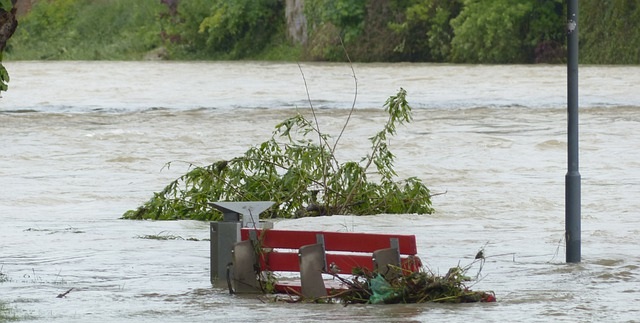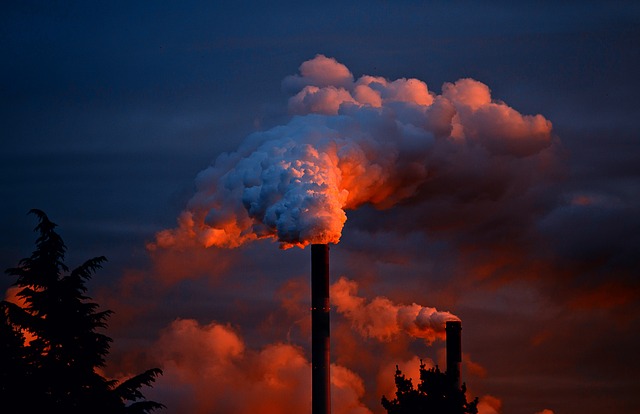People across Pakistan have noticed a unique dry and windy weather in the past two weeks which has never been experienced in Pakistan before. People are complaining about extremely dry weather, fast gusty winds, dry itchy skin, nose bleeds, high static electricity and increased in issues related to seasonal allergies, and this is an ongoing discussion on Twitter (tweet below) with many people sharing similar experiences in the past two weeks. Everyone is asking what’s up with the weather, so we have decided to try and find an answer.
It’s been a week that Pakistan is under severe weather of strong winds reaching up to 50-60km/hr, that has significant impact on daily life as well including effects on travel/health; increase in allergies, nosebleeds and some have been reporting strong static charges as well.
— Salman. ⑃ ∞ (@SalmanNaseer) April 2, 2021
Pakistan’s climate is generally arid, which means it experiences little rainfall over all and whatever rainfall it receives is usually seasonal. The variation in seasonal temperatures is also high, with hot summers and cool winters.
Below we have collected the average data for the month of March for the last 5 years. It is clear from the data that humidity levels are at their lowest as compared to previous 5 years! This has resulted in the current dry weather which is causing a lot of problems for the people.
KARACHI
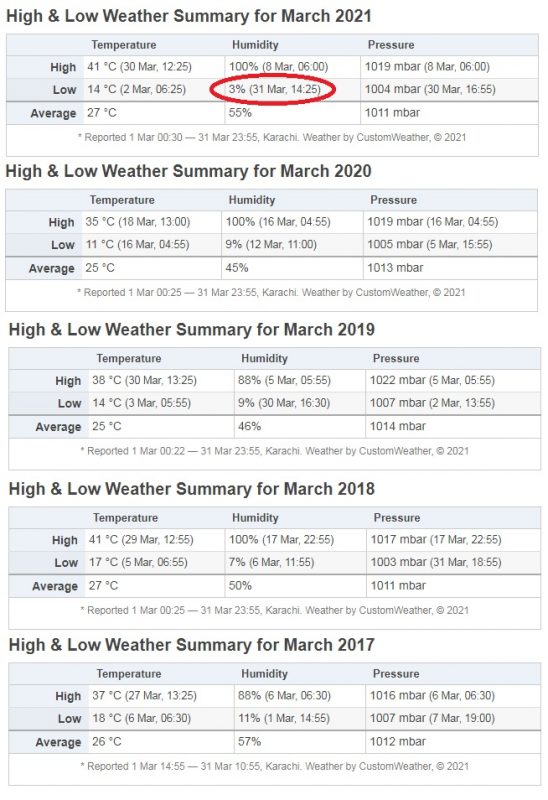
LAHORE
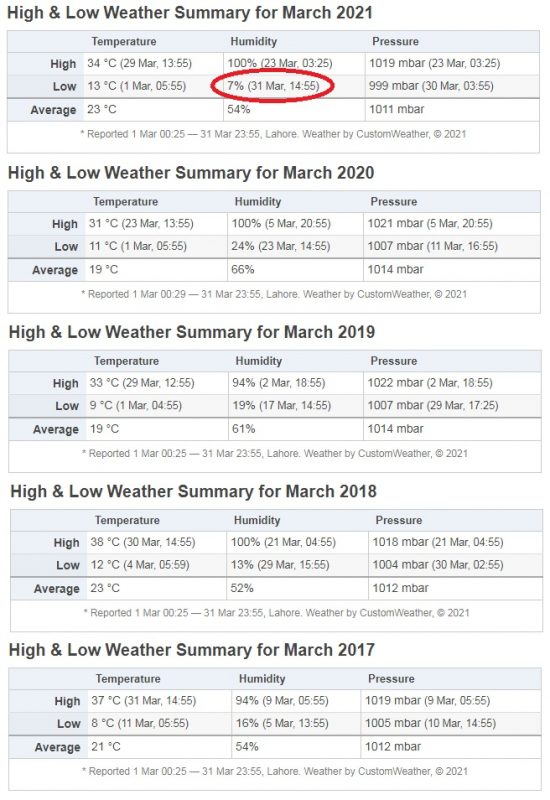
PESHAWAR
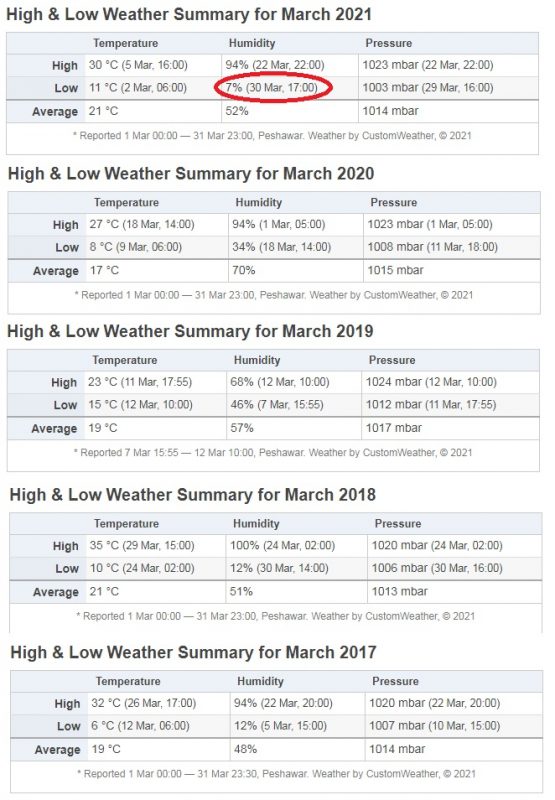
QUETTA
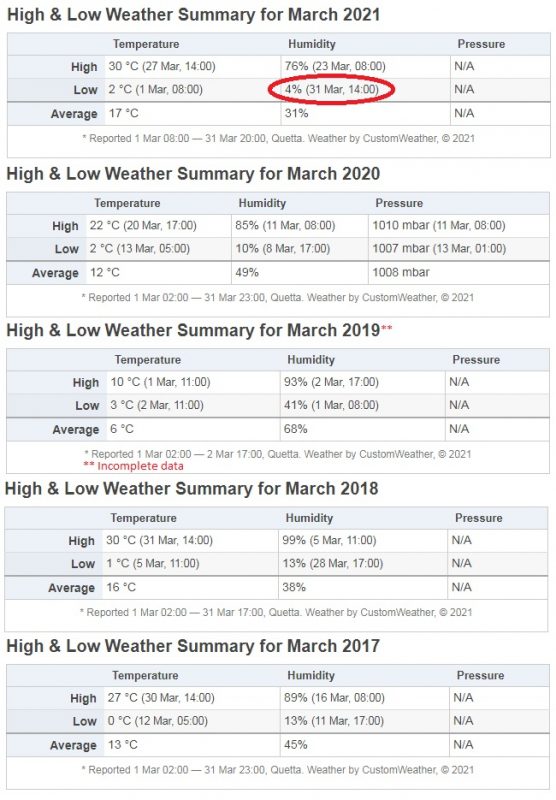
[Source: TimeAndDate.com]
As seen from the data above, this type of weather is unprecedented in Pakistan and very problematic. Pakistan is one of the most vulnerable countries when it comes to climate change and the effects are visible now. Everyone is experiencing it and being affected by it. Pakistan is already an arid country and such low levels of humidity as compared to the last five years for the month of March are a source of concern. [Also Read: Climate Change and Its Impact on Pakistan]
EFFECTS OF LOW HUMIDITY WEATHER:
HEALTH PROBLEMS:
Dry weather can worsen and lead to many different types of health problems like worsening allergies; respiratory issues like asthma, bronchitis and sinusitis; nosebleeds; skin issues; dryness of eyes/nose/throat and sore throat etc. Indoor humidity below 30 % is considered too low, while ideal humidty is in the range of 30-50%.
Dry itchy skin: When there is less moisture in the air it also affects your skin, which becomes dry and as a result ithy.
Nosebleeds: Dry air is one of the most common causes of nosebleeds. It dries up and irritates internal lining tissues of the nasal passage and causes crusting inside nose which results in nosebleeds.
Increase in allergies: Higher levels of humidity keep the inside lining of the throat and nasal passage moist and dry weather dries up and irritates these lining tissues and sinuses, removing the protective layer of mucous thus exacerbating the symptoms of allergy. As a result a person will sneeze more in hot dry weather.
[Also Read: Is Climate Change the Reason Behind Worsening Allergy Season?]
UNCOMFORTABLE ENVIRONMENT:
Dry weather also makes the environment around us really uncomfortable, people suffer from different health issues as well as general dehydration of the body as the fluid content of the body is reduced due to respiration and because of evaporation from skin causing dry skin, and there also is a general increase in the static electric charge on surfaces which can be very annoying.
Static charge: In a humid weather the static charge that is built up on surfaces is easily dissipated, while in dry weather it is dissipated less easily, thus we get zapped by static charge more often. This is why
NEGATIVE IMPACTS ON THE ENVIRONMENT:
Damaging crops: Crops are being damaged due to these high speed winds and the dry weather. Many crops are being uprooted.
Drying of Soils: Dry winds absorb moisture from their surroundings, including the soil, which results in soils losing their moisture content and drying out. Over years this could lead to soil erosion and desertification.
Droughts: Droughts can result from prolonged dry weather. Droughts cause failure of crops which leads to food insecurity.
RECOMMENDATIONS:
- Use air coolers (Lahori cooler/coolers that use water) to help you keep your indoor environment humid and cool.
- Use moisturizers frequently to keep yourskin moisturized
- Use air humidifiers indoors.
- Drink lots of water/take lots of fluids.
- Take allergy medicines (consult your doctor, please don’t self-medicate)
- Use indoor plants and plant more trees around your house.
Also Check Out:
Food Security and Climate Change in Pakistan
The Impacts of Climate Change on Agriculture in Pakistan
I hope you all liked this post! Please comment below if you have any suggestions, comments, or feedback! We at #envpk love hearing from our readers! Thanks!



